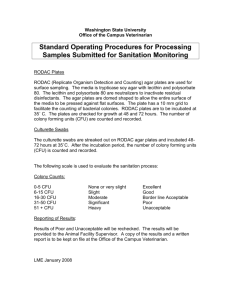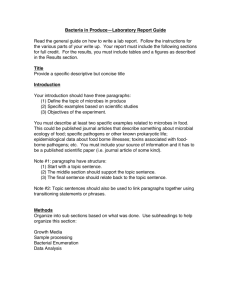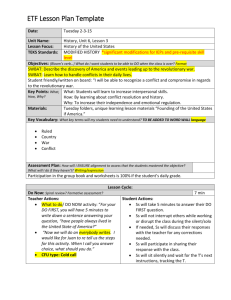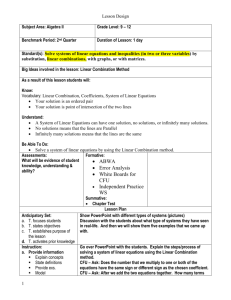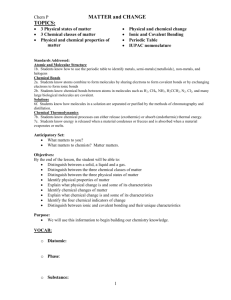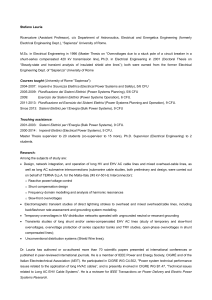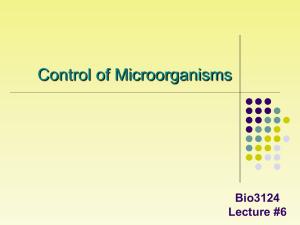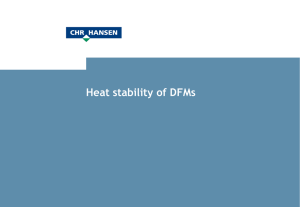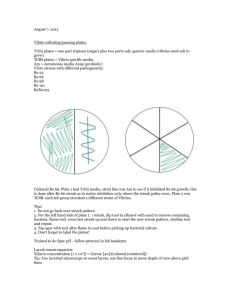Growth Promotion Test Frequently Asked Questions
advertisement
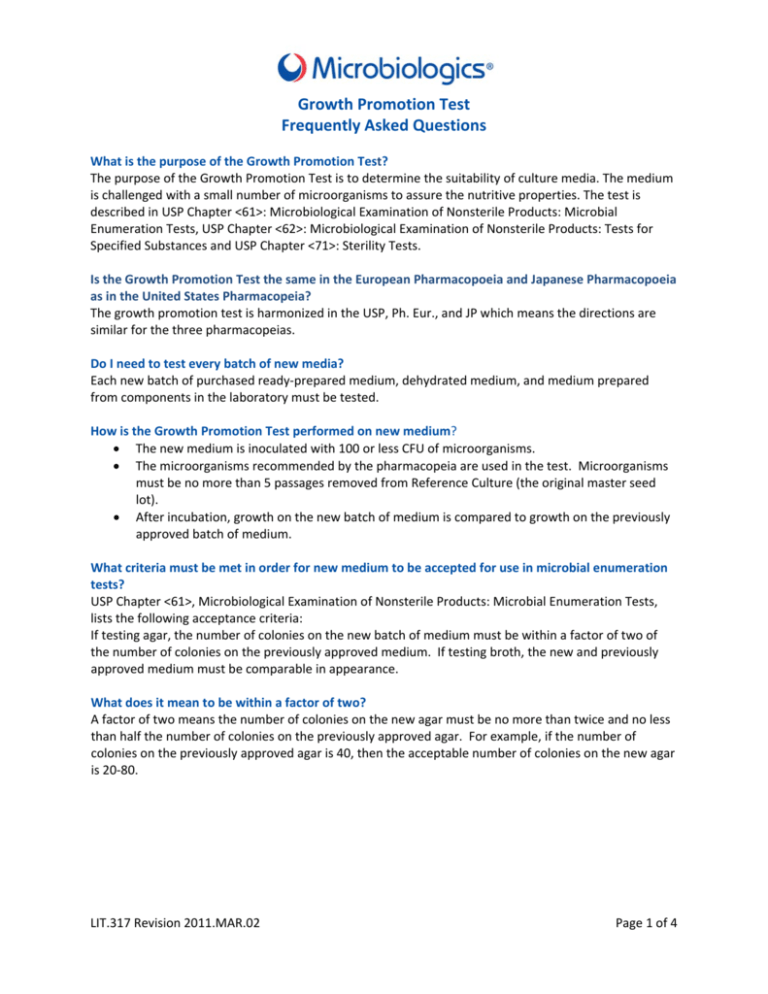
Growth Promotion Test Frequently Asked Questions What is the purpose of the Growth Promotion Test? The purpose of the Growth Promotion Test is to determine the suitability of culture media. The medium is challenged with a small number of microorganisms to assure the nutritive properties. The test is described in USP Chapter <61>: Microbiological Examination of Nonsterile Products: Microbial Enumeration Tests, USP Chapter <62>: Microbiological Examination of Nonsterile Products: Tests for Specified Substances and USP Chapter <71>: Sterility Tests. Is the Growth Promotion Test the same in the European Pharmacopoeia and Japanese Pharmacopoeia as in the United States Pharmacopeia? The growth promotion test is harmonized in the USP, Ph. Eur., and JP which means the directions are similar for the three pharmacopeias. Do I need to test every batch of new media? Each new batch of purchased ready‐prepared medium, dehydrated medium, and medium prepared from components in the laboratory must be tested. How is the Growth Promotion Test performed on new medium? • The new medium is inoculated with 100 or less CFU of microorganisms. • The microorganisms recommended by the pharmacopeia are used in the test. Microorganisms must be no more than 5 passages removed from Reference Culture (the original master seed lot). • After incubation, growth on the new batch of medium is compared to growth on the previously approved batch of medium. What criteria must be met in order for new medium to be accepted for use in microbial enumeration tests? USP Chapter <61>, Microbiological Examination of Nonsterile Products: Microbial Enumeration Tests, lists the following acceptance criteria: If testing agar, the number of colonies on the new batch of medium must be within a factor of two of the number of colonies on the previously approved medium. If testing broth, the new and previously approved medium must be comparable in appearance. What does it mean to be within a factor of two? A factor of two means the number of colonies on the new agar must be no more than twice and no less than half the number of colonies on the previously approved agar. For example, if the number of colonies on the previously approved agar is 40, then the acceptable number of colonies on the new agar is 20‐80. LIT.317 Revision 2011.MAR.02 Page 1 of 4 Growth Promotion Test Frequently Asked Questions What criteria must be met in order for new medium to be accepted for use in tests for specified microorganisms? USP Chapter <62>, Microbiological Examination of Nonsterile Products: Tests for Specified Microorganisms, lists the following criteria: 1. The number of colonies on the new agar must be comparable to the number of colonies on the previously approved agar. It is not necessary to be within a factor of two. When testing broth, results should be comparable. 2. Microorganisms which should be inhibited should not grow. 3. Colonies on the new medium should be comparable in appearance and indication reactions to colonies on previously approved medium. Should I test the new batch of media and the previously approved batch of media in parallel in order to compare them? Microbiologics strongly recommends using parallel testing. In parallel testing the new medium and the previously approved medium are inoculated with the same microorganism suspension, by the same technician, using the same method and same environmental conditions. The only variable is the medium. What if I cannot perform parallel testing because I no longer have the previously approved media? Historical data can be used. Use the same microorganism lot that was used to test the previously approved medium. How can I ensure good results when I perform Growth Promotion tests? Below are a few of our recommendations for successful Growth Promotion testing. For more information about using Microbiologics products for Growth Promotion testing, check out our helpful Growth Promotion Test Guide. • Test the new medium and the previously approved medium side by side. • When testing selective medium, test non‐selective medium in parallel. • Use a spreader to spread the inoculum so that cells do not stick together. • Use a vortex mixer to mix the suspension after delivering each inoculum. LIT.317 Revision 2011.MAR.02 Page 2 of 4 Growth Promotion Test Frequently Asked Questions Microbiologics sells four different products for Growth Promotion testing, which one should I choose? Use the comparison chart below to determine which product best suits your needs. EZ‐Accu Shot™ Select EZ‐Accu Shot™ EZ‐CFU™ One Step EZ‐CFU ™ For small volume user For small volume user For medium volume user For large volume user Delivers <100 CFU/0.1mL Delivers <100 CFU/0.1mL Delivers <100 CFU/0.1mL Delivers <100 CFU/0.1mL No dilution step No dilution step No dilution step One dilution step 10 tests per vial 10 tests per vial 19 tests per vial >90 tests per vial Stable for 8 hrs. after hydration, when refrigerated Stable for 8 hrs. after hydration, when refrigerated Stable for 8 hrs. after hydration, when refrigerated* Must be used within 30 minutes of incubation Quick‐dissolve Quick‐dissolve Pre‐warm 30 minutes Pre‐warm 30 minutes Five different strains per kit One strain per kit One strain per kit One strain per kit * Exceptions to the 8 hour stability are C. perfringens, 0318Z and B. fragilis, 0320Z, which must be used within 30 minutes of hydration. Where can I find a list of microorganism strains that are available in each product line? Visit the Products page on our website, or click here to download an electronic version of our current catalog. At what temperature should the microorganisms be stored? The microorganisms should be stored at 2 – 8°C. What should I use to hydrate the lyophilized pellets? Use the hydration fluid that came with the kit you received. The amount of hydration fluid in each vial varies between the product lines. The EZ‐Accu Shot™ and EZ‐Accu Shot™ Select kits include 5 vials with 1.2 mL of hydration fluid in each. EZ‐CFU™ and EZ‐CFU™ One Step kits include 10 vials of 2 mL of hydration fluid in each. Can I use EZ‐Accu Shot™, EZ‐CFU™ One Step or EZ‐CFU™ for Growth Promotion testing of selective media? Yes, but also test nonselective media in parallel. Nonselective media is needed as a control because recovery is typically not as high on selective media compared to nonselective media LIT.317 Revision 2011.MAR.02 Page 3 of 4 Growth Promotion Test Frequently Asked Questions The medium I am testing is highly selective. I cannot recover microorganisms when I use EZ‐Accu Shot™ to inoculate the media with less than 100 cfu. What can I do? KWIK‐STIK™ Plus two passage microorganisms are ideal for Growth Promotion testing when testing a highly selective medium such as Cetrimide medium. To perform the test, grow the KWIK‐STIK Plus microorganism on nonselective media. In order to estimate the concentration of an inoculum, use a traditional method such as the turbidimetric method to produce an inoculum of 100 CFU or less. I need to inoculate my agar with at least 100 CFU. What product should I use? Microbiologics has several options available: 1. E3 Epower™ microorganisms contain 1000 – 9900 CFU per pellet. In order to deliver 100 CFU or more, hydrate one pellet in 1.0 mL Phosphate Buffer pH 7.2 and inoculate media with 0.1 mL. 0.1 mL inoculum contains 100‐990 CFU. Phosphate Buffer pH 7.2 is not provided with this product. 2. EZ‐CFU™ microorganisms contain 1000 – 9900 CFU per pellet. In order to deliver more than 100 CFU, hydrate two pellets in the 2.0 mL vial of phosphate buffer provided in the canister and inoculate media with 0.1 mL (100‐990 CFU). 3. KWIK‐STIK™ Plus microorganisms are qualitative microorganisms which are only two passages from Reference Culture. Grow the organism on nonselective agar and use a traditional method such as the turbidimetric method to produce an inoculum which is more than 100 CFU. LIT.317 Revision 2011.MAR.02 Page 4 of 4
